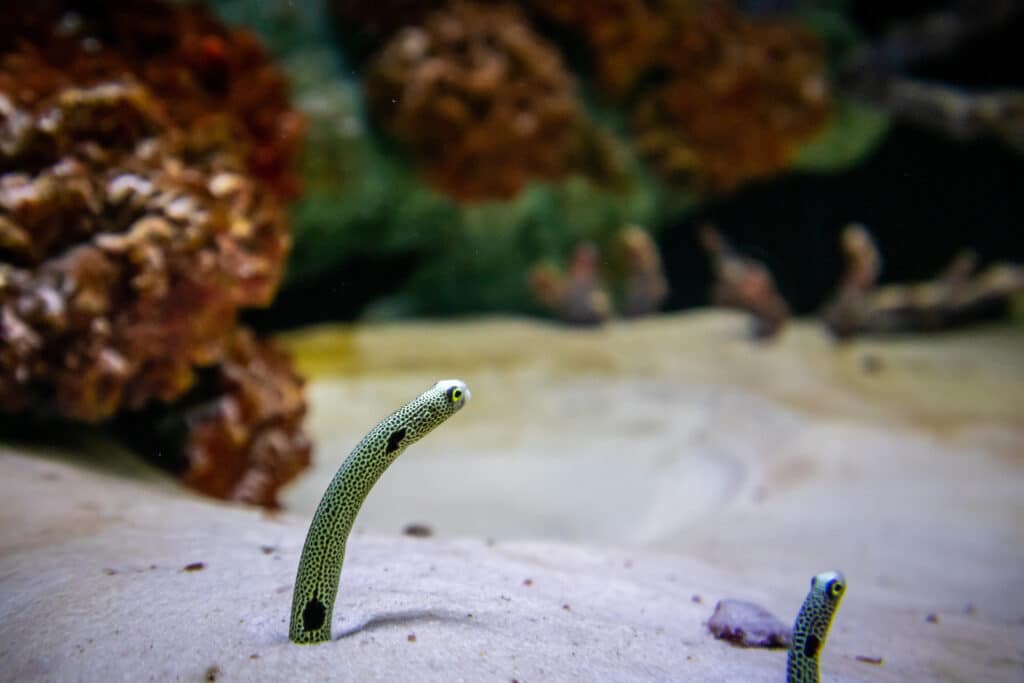Chalice Coral: A Comprehensive Guide for Beginners
Corals are not just beautiful creatures that add color to an underwater world, but they also play a vital role...
Jim Sabellico
January 27, 2022

Let’s say you were able to find the best location for your saltwater tank inside your house. That means you can now get started on what to put on the bottom of your tank next. You have a number of options that you want to consider when it comes to choosing the kind of substrate for your saltwater tank. Of course, since there are a lot of varieties to choose from, finding the perfect substrate can become a difficult task.
In this article, we will help you in narrowing down your choices and find the best substrate for your saltwater tank.
The substrate is an important part of a saltwater tank. It can provide a place for bacteria to grow and help filter the water, and it can also provide a place for fish to hide and lay eggs. Some substrates are better at filtering water than others. Some are more porous, which means they have lots of tiny holes that allow water to flow through them easily. Others are less porous and don’t let as much water through and they also come in different sizes. Choose one that is big enough to cover the bottom of your tank, but not too big or it will be hard to clean. It’s fascinating how the substrate has a lot of function in your reef tank. So, what are the other important roles that the substrate plays? Let’s check it out.
Substrates are materials used in saltwater tanks to provide a surface area for beneficial bacteria to colonize and grow. This is important for biological filtration, which is the process of breaking down waste products into less harmful substances. Each type has its own unique properties that make it better or worse suited for certain applications. When selecting a substrate for your aquarium, be sure to consider the needs of your fish and plants as well as the size and layout of your tank.
Saltwater tanks can be beautiful additions to any home, and part of what makes them so appealing is the substrate. The substrate does not only play a biological role. It also has a huge impact on the overall look and feel of your saltwater tank. There are many different types of substrates available for saltwater tanks, but not all of them are created equal. Some substrates are better at providing a natural look to the tank, while others are more beneficial for the fish and corals that live in it.
One of the most important functions of substrates is to provide shelter for burrowing or sand-sifting creatures. By digging into the substrate, these animals can create a safe haven from predators and harsh environmental conditions. The substrate also helps to stabilize the animal’s environment by providing insulation and protection from wind and rain. In addition, the substrate can help to stabilize the beach or dune environment by preventing erosion.
Another important function of substrates is to provide a food source for burrowing or sand-sifting creatures. By filtering through the sand or soil, these animals can access microorganisms and other nutrients that are essential for their survival. The substrate also helps to protect these organisms from predators and environmental conditions. By preserving the substrate, we can help to maintain the health of these creatures and the ecosystems that they inhabit.
Denitrification in saltwater tanks can have a significant impact on the overall health and function of the tank. The use of live rock and sand can help to provide a natural environment for bacteria to break down nitrates. Using an appropriate substrate can help to ensure that all of the nutrients in the water are properly processed and create a healthy and sustainable saltwater tank.
Saltwater tanks are a great way to have a small piece of the ocean right in your home. They can be a beautiful addition to any room, and they can also be a lot of fun to maintain. One of the most important decisions you will make when setting up your saltwater tank is what type of substrate to use. There are many different options available, and each has its own benefits and drawbacks. Here is a list of the most common types of substrates for saltwater tanks:
Live sand is the most popular type of substrate for saltwater tanks. When it comes to substrates for saltwater tanks, it is one of the most popular options. It’s made up of small pieces of coral, which helps to create an environment that is similar to the ocean floor. One of the main benefits of using live sand in your tank is that it helps to filter out debris and pollutants from the water. It also provides a place for bacteria to grow, which helps to break down waste products. This can be beneficial for your tank, as it can help to keep the water clean and healthy. If you are looking for a natural way to filter your saltwater tank, then this is your best option. It is also a good choice if you are looking for a substrate that will help to create a realistic ocean environment in your tank.
Crushed coral is another popular type of substrate. It is made up of small pieces of Coral Reefs that have been broken down into smaller sizes. This type of substrate can be used in both fresh and saltwater tanks. It is often used to help buffer pH levels and provide essential minerals to fish and plants.
One downside to using crushed corals as a substrate is that it can be quite expensive. There are also concerns about its impact on ocean ecosystems since it comes from real coral reefs. Some alternative substrates that are becoming more popular include sand and crushed glass.
So what is the best substrate for your saltwater aquarium? It depends on your own individual preferences and needs. Crushed coral is a good option for those who want to provide some extra nutrients to their fish and plants, but there are other choices available as well. Ultimately, it’s up to you to decide what will work best for your tank.
Aragonite sand, which is composed of calcium carbonate, is one of the most commonly recommended substrates for saltwater tanks. It is a fine-grained product made up of small pieces of coral skeletons, and it helps to buffer the water’s pH level and provides essential minerals for fish and other marine life. It is also a good choice for reef tanks, as it can provide a natural habitat for corals and other invertebrates.
Oolite is a type of crushed corals that is used as a substrate in saltwater tanks. It forms from ooids, spherical sand grains formed in concentric layers. One benefit of using oolite as a saltwater tank substrate is that it helps to buffer the water’s pH level. This can be helpful for tanks with fish or invertebrates that prefer specific pH levels. Oolite also acts as a filter, helping to clean the water and reduce algae growth.
If you are looking for an alternative to sand or gravel as a saltwater tank substrate, oolite may be a good option for you. It is affordable, easy to use, and helps to keep the water healthy for your fish and invertebrates. Just be sure not to use it with shrimp or other delicate creatures and avoid using it if you have an under gravel filter. For most reef tanks though, Oolite makes a great substrate choice!
As a fish enthusiast, you know that having a saltwater aquarium is a great way to enjoy some beautiful underwater creatures. What you may not know, however, is that the substrate in your tank can make a big difference in the look of your tank. It is also known that different colors of saltwater tank substrate can create different moods in your fish. Some people believe that black substrate creates a more aggressive environment, while white or light-colored substrates are believed to be more calming. There is no right or wrong answer when it comes to the color of your substrate – it all depends on what you want your tank to look like and what type of fish you want to keep.
When it comes to the colors of saltwater tank substrate, there are a few different options to choose from. Here are some of the most popular colors and what they mean for your tank:
When it comes to choosing the right color of substrate for your saltwater aquarium, there is no one-size-fits-all answer. It all depends on the type of fish you want to keep and the mood you want to create in your tank. If you’re not sure which color to choose, beige or brown substrates are usually a safe bet!
In the marine aquarium hobby, there are two types of sand that are regularly used: dry sand and live sand. You may be wondering what the difference is between the two.
Dry sand is just that, dry. It has been cleaned and sterilized and is ready to be used in your tank, but it does not provide any benefits to the tank ecosystem. In fact, dry sand can be harmful to marine life because it can clog up their gills. Live sand, on the other hand, has not been cleaned or sterilized. It still contains microorganisms that can help cycle your tank and establish a healthy saltwater ecosystem.
Many people prefer to use live sand because it helps speed up the cycling process, and it also provides a natural habitat for beneficial marine organisms. However, using live sand does come with some risks. If you are not careful when adding it to your tank, you could end up with an outbreak of undesirable organisms.
Choosing the type of sand might be a hard task at first. But it will still depend on your own preferences and the needs of your tank. If you are new to marine aquariums, it might be a good idea to start out with dry sand until you get the hang of things. Once you have some experience under your belt, you can experiment with using live sand in your tank. Live sand is a key component of the reef tank ecosystem, and it can help to create a healthy and thriving environment for your fish and other marine life. Just make sure to take the necessary precautions to avoid any problems.
There is no definitive answer to this question. The amount of substrate you need will depend on the size of your tank and the type of aquarium you are setting up. In general, you will need at least two inches of substrate for a fish-only tank or three to four inches for a reef tank. If you are using live sand, you will need even more – about six inches. If you are not sure how much substrate to get, it is always better to buy too much than not enough. You can always remove the excess substrate later if needed. When it comes to the substrate for saltwater tanks, there are a few things to keep in mind.
First, the type of substrate you use will depend on the type of aquarium you are setting up. If you are setting up a fish-only tank, you can use any type of substrate that you like. However, if you are setting up a reef tank, you will need to use live sand instead of regular sand. Live sand is more expensive, but it is essential for the growth of corals.
Second, you will need to make sure that the substrate is compatible with your tank’s filter. Some types of substrates can clog up filters, so be sure to check with your filter manufacturer before purchasing any substrate.
Finally, you will need to make sure that the substrate is the correct size for your tank. If the substrate is too large, it can clog up your filter and make cleaning your tank difficult. If the substrate is too small, it will not provide enough surface area for bacteria to grow and will not be as effective at removing toxins from the water.
Setting up a reef tank can be a daunting task. There are so many things to consider, from the type of fish and the corals you want to keep, to the type of water filter you need. One of the most important decisions you’ll make when setting up your tank is what kind of substrate to use. There are many different types available, but not all of them are suitable for a reef tank. The wrong substrate can lead to disaster, while the right one can help keep your tank healthy and looking great. Here are a few things to consider when choosing a substrate for your reef tank:
In the end, nothing will go wrong as long as you follow whatever works best for you. And as long as you take care of your reef tank and whatever marine organism you choose to live in it, everyone will be happy!

I am the founder of J. Louis, a digital marketing agency focused on providing innovative solutions and strategies built on a foundation of creative design and technology. A family man who loves travel and reef tanks, I’ve been coined as a jack of all trades, master of a few of them, most specifically website and sales funnel design, monetization and growth strategies, and viral marketing. I began pursuing my passions for business by cutting my neighbor’s lawns when I was just 8 years old and never looked back. Over the past 20 years, I have amassed significant experience providing consulting, design and development services for Fortune 500 companies, government, retail, private individuals, and A-list celebrities.
Corals are not just beautiful creatures that add color to an underwater world, but they also play a vital role...
As we move into the new year, it's time to start thinking about what reef tank LED lighting kits will...

Proceeds from all purchases go directly to Great Barrier Reef Foundation and supporting their mission.
Want to stay connected with all the latest news in the Reef Tank Addict community? Drop your email below!
Proudly Supporting The Great Barrier Reef Foundation
